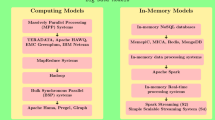Abstract.
One of the most important advantages of database systems is that the underlying mathematics is rich enough to specify very complex operations with a small number of statements in the database language. This research covers an aspect of biological informatics that is the marriage of information technology and biology, involving the study of real-world phenomena using virtual plants derived from L-systems simulation. L-systems were introduced by Aristid Lindenmayer as a mathematical model of multicellular organisms. Not much consideration has been given to the problem of persistent storage for these simulations. Current procedures for querying data generated by L-systems for scientific experiments, simulations and measurements are also inadequate. To address these problems the research in this paper presents a generic process for data-modeling tools (L-DBM) between L-systems and database systems. This paper shows how L-system productions can be generically and automatically represented in database schemas and how a database can be populated from the L-system strings. This paper further describes the idea of pre-computing recursive structures in the data into derived attributes using compiler generation. A method to allow a correspondence between biologists' terms and compiler-generated terms in a biologist computing environment is supplied. Once the L-DBM gets any specific L-systems productions and its declarations, it can generate the specific schema for both simple correspondence terminology and also complex recursive structure data attributes and relationships.
Similar content being viewed by others
References
Chen IA, Markowitz VM (1995) An overview of the object-protocol model (OPM) and OPM data management tools. Information Systems (20)5, pp 393–418
Chen PP (1996) The Entity-Relationship Model: Toward a Unified View of Data. ACM Transactions on Database Systems 1(1): 9–36.
Chen YP, Colomb RM (1998) Design: a visual database development system. In Verma B, Liu Z, Sattar Z, Surawski R, You J (eds). Proceedings of the second IEEE international conference on intelligent processing systems, 4–7 August, Gold Coast, Australia. IEEE CS Press, Los Alamitos, CA, pp 198–202
Chen YP, Colomb RM (1999) Decision support in bioinformatics research. In Burstein F (ed). Proceedings of the fifth international conference of the International Society for Decision Support Systems, International Society for Decision Support Systems, pp 1–9
Chen YP, Colomb RM (2000) Querying recursive structures without recursive queries. In Orlowska ME (ed). Proceedings of the 11th Australian database conference, ADC2K, Vol 22 No 2 of Australian Computer Science Communication, 31 January–3 February Canberra, Australia. IEEE CS Press, Los Alamitos, CA, pp 21–27
Codd EF (1970) A relational model for large shared data banks. Communications of the ACM 13: 6
Colomb RM (1998) Deductive databases and their applications. Taylor & Francis, London
Elamasri R, Navathe SB (1989) Fundamentatals of database systems. Benjamin/Cummings, Redwood City, CA
Fleury V, Gouyet J-F, Leonetti M (2001) Branching in nature: dynamics and morphogenesis of branching structures from cell to river networks. Springer, Berlin
Grosch J (1992) Compiler generation: a toolbox for compiler construction. Technical Report 16, Gesellschaft fiir Mathematik und Datenverarbeitung mgH, Forschungsstelle ander Universitat Karlsruhe
Hanan J (1992) Parametric L-systems and their application to the modelling and visualization of plants, PhD paper, Department of Computer Science, University of Regina
Hanan J (1995) Virtual plants: integrating architectural and physiological plant models. In Binning P, Bridgman H, Williams B (eds). MODSIM'95 international congress on modelling and simulation proceedings 1, pp 44–50
Hanan J, Room P (1997) Practical aspects of virtual plant research. In Michalewicz M (ed) Plants to ecosystems. Advances in Computational Life Sciences, Vol 1. CSIRO, Melbourne, pp 28–44
Leebaert D (1995) The future of software. Massachusetts Institute of Technology, Graphic Composition Inc
Lindenmayer A (1968) Mathematical models for cellular interactions in development: Parts I and II. Journal of Theoretical Biology 18: 280–315
Lindenmayer A (1974) Adding continuous components to L-systems. In Rozenberg G, Salomaa A (eds). L Systems. Lecture Notes in Computer Science 15, Springer, Berlin, pp 53–68
Markowitz VM, Ritter O (1995) Characterizing heterogeneous molecular biology database systems. Journal of Computational Biology 2(4): 3
Pittman T, Peters J (1992) The ART of compiler design. Prentice-Hall, Englewood Cliffs, NJ
Prusinkiewicz P, Hanan JS (1989) Lindenmayer systems, fractals, and plants. Verlag, Lecture Notes in Biomathematics, Springer, Berlin
Prusinkiewicz P, Lindenmayer A (1990) The algorithmic beauty of plants. Spring, New York
Prusinkiewicz P, Hanan JS, Mech R (2000) An L-systems-based plant modelling language. In Nagl M, Schurr A, Nunch M (eds). Applications of graph transformation with industrial relevance. Lecture Notes in Computer Science 1779, Springer, Berlin, pp 295–410
Room P, Maillette L, Hanan J (1994) Module and metamer dynamics and virtual plants. Advances in Ecological Research 25: 105–157
Room P, Hanan J (1995) Challenging the future. In Constable GA, Forrester NW (eds). Proceedings of the world cotton research conference 1, CSIRO, Australia, pp 40–44
Room P, Hanan J, Prusinkiewicz P (1996) Virtual plants: new perspectives for ecologists, pathologists and agricultural scientists, Trends in Plant Science 1: 33–38
Author information
Authors and Affiliations
Corresponding author
Rights and permissions
About this article
Cite this article
Chen, YP., Colomb, R. Database Technologies for L-System Simulations in Virtual Plant Applications on Bioinformatics. Knowledge and Information Systems 5, 288–314 (2003). https://doi.org/10.1007/s10115-002-0087-0
Received:
Revised:
Accepted:
Issue Date:
DOI: https://doi.org/10.1007/s10115-002-0087-0




